>
>
Chicken breast has gotten a bad rap for a long time.
However, you can safely say that’s not the chicken breast’s fault, but the fault of the cooks who do not know how to properly prepare it.
(It is the same dilemma with fish, veal, pork and most other protein besides red meat – the taste and texture of properly cooked protein is so wonderful yet so elusive in most restaurants these days).
I remember when I was a teacher and I showed my students how incredibly juicy and tasty a breast of chicken can be when cooked in a professional manner. Before the demo, I always asked “why do we prefer chicken leg over chicken breast” and the answer was always: “because breast are dry and tasteless”. How very surprised they all were when I proved them wrong. 🙂
So, the way to do it is to cook it to 160F to 162 F depending on the type and thickness of the protein, then let the carry-over heat do its magic; after a short rest, the protein should reach between 164F and 165F the moment it reaches the guest, but it must never exceed that temperature or it will be dry !!! During my time and before that, cooks would never think of using a thermometer to check the doneness of food – everything was dictated by the experience we garnered over many years of real cooking. Now imagine, some of our successors are not even able to find the center of the protein to get the temperature right (no kidding). And of course, if cooked too fast, protein will also end up less than stellar.
Having said all that, you might understand that I would never order a chicken breast in a restaurant these days, because the absolute majority of cooks nowadays does not know how to do a chicken breast justice. (Again, the same holds true with pork, fish and other protein which are so wonderful tasty, tender and juicy when handled with expertise).
Unfortunately, because of lack of cooking skills, the new “experts” will make you believe that only protein which is under-cooked or raw will be juicy 😦
Ok, ok, so I vented a bit, I beg your pardon…..
As of today’s dish, I resorted sheepishly to the habit of naming the dish in french, since “Poulet Beaucoup D’Ail” sounds so much better than “Chicken With Lot’s Of Garlic“. ( Or maybe “Pollo Con Un Monton De Ajo” anyone ?) 🙂
And for those of you who do not believe in lots of garlic, just replace the garlic with botton-mushrooms. As for the gnocchi with black beans, lately I have prepared that combination often and in many different variations – gnocchi with butter beans, gnocchi with chick peas, gnocchi with edamame etc, all sautéed in herb butter, pesto, tomato sauce, chili oil, cheese sauce and so forth. The added texture of the beans make the gnocchi even more enjoyable than just plain with butter or sauce.
>
Bon Appetit ! Life is Good !
>
>
>
>
>
>
Preparation :
To read instructions, hover over pictures
To enlarge pictures and read instructions, click on pictures
>
>
>
- season chicken breast with kosher salt and cayenne pepper
- dredge chicken in flour, shake of excess
- saute slowly together with garlic cloves in olive oil (replace garlic with botton mushrooms if you prefer)
- the garlic should be golden, crispy on the outside and creamy on the inside
- remove chicken and most garlic, reserve
- in the remaining olive oil, saute cooked beans until heated
- add fresh cooked gnocchi, season with kosher salt and cayenne pepper
- chiffonade fresh basil
- add chiffonade to bean/gnocchi mix, check/adjust seasoning
- to serve, sprinkle with finely grated parmigiano reggiano
- top with sliced chicken breast
- top with the remaining olive oil and the garlic cloves, sprinkle with more basil
- Poulet Beaucoup D’Ail
- Poulet Beaucoup D’Ail
- Poulet Beaucoup D’Ail
>
>
>
>
>

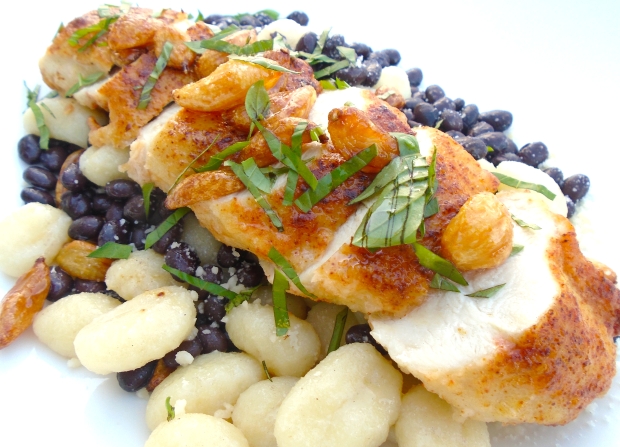




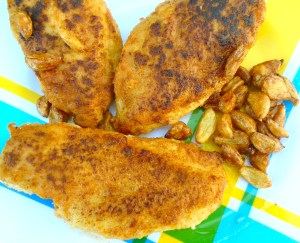




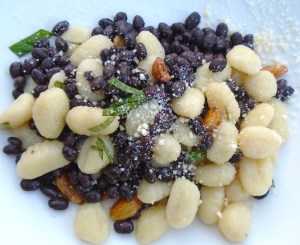


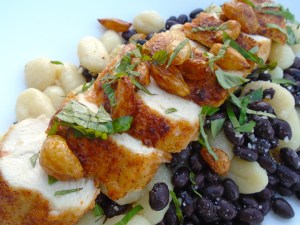
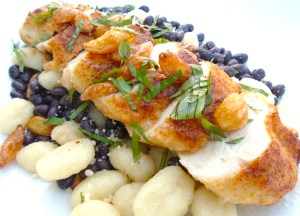

I agree totally with you, chef. I have always been a “breast” man, myself! You have to know how to handle any breast, to make them right. Now, one thing I do when resting my proteins is, I cover the product. I explain that “steam” is moisture and you don’t want to let it escape! Between resting and the covering, my chicken or like you mentioned, really any protein, is extremely succulent and juicy. Pork chops, salmon… people always comment how juicy they are and how I do it.
So great article and again, I hate to say, but the younger chefs are just that… younger! It is like a chef/instructor in culinary school once said… “Until you have done it a thousand times, you haven’t done it”~
Peace
LikeLiked by 1 person
There you have it, Joseph 🙂 Cheers !
LikeLike
Looking fabulous, and the pictures are great too!
LikeLiked by 1 person
Thanks Bente, I’ve got to learn a lot from you 🙂
LikeLike
I’m intrigued and very keen to try cooking a nice tasting chicken breast now. Roughly how long did you cook the breast on each side before removing it from the pan?
LikeLiked by 1 person
Annabelle,
probably 3-4 minutes, but it depends entirely on the heat and the thickness of the breast.
May I suggest you invest in a food thermometer and follow the above instructions, that will probably be your best bet 🙂
Cheers and Bon Appetit !
Hans
LikeLike